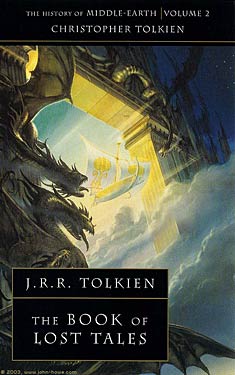JRR Tolkien, edited and commentary by Christopher Tolkien
Completed 8/10/2015, Reviewed 8/10/2015
3 stars
Part II is a continuation of the texts Tolkien included in
his Lost Tales writings from the 1910s.
The division between the two parts is a publishing choice. However, it is conveniently divided between
what could be called genesis stories, those which focus more on creation and
the gods, and later stories, those that deal with elves, humans, and the other
beings. Most of the stories here we’ve
already encountered once or twice before.
But in all cases, they are the earliest documentation of these
stories. While they are the banner
stories of Tolkien’s First Age imaginarium, reading them again but this time in
archaic style makes for a tough go. And
to give them a fair shake, you really need to forget most of what you remember
from The Silmarillion and The Unfinished Tales, something I was not completely
able to do.
 The first story is the tale of Beren and Luthien. However, here, Luthien is named Tinuviel and
Beren is an elf, not a man. Even though
Beren is from a different branch of the elves, one not on good terms with
Tinuviel’s family, it doesn’t carry the same weight as if he were a man in love
with an elf. Tinuviel comes across as
very young and naïve. She doesn’t have
the same maturity I got from the later piece.
So the story seems less tragic, though tragedy abounds.
The first story is the tale of Beren and Luthien. However, here, Luthien is named Tinuviel and
Beren is an elf, not a man. Even though
Beren is from a different branch of the elves, one not on good terms with
Tinuviel’s family, it doesn’t carry the same weight as if he were a man in love
with an elf. Tinuviel comes across as
very young and naïve. She doesn’t have
the same maturity I got from the later piece.
So the story seems less tragic, though tragedy abounds.
Turin Turambar also has a less tragic feel, despite this
being the most tragic of all of Tolkien’s stories. With murder, suicide, and incest, you would
think it wouldn’t be able to escape bringing you down. Here though, I think the problem is the
writing style. I never felt like I
really got to know Turin because the reading is so difficult.
The Fall of Gondolin, another tragic tale, had a little more
going for it. It had epic battle scenes
that were really well drawn and paced.
It had orcs, balrogs, and mechanical dragons swarming on the last
holdout of elves free of the domination of the evil god Melko. For some reason, this was easier to follow
despite the language.
The best of the stories was the Nauglafring, or the Necklace
of the Dwarves. I think this was due to
it being the first story where dwarves are major characters. Also, it is the story that is most different
from its counterpart in the Silmarillion.
An elf king has a huge cursed treasure dumped on him. A dwarf in the court convinces him to not
throw away the treasure, but to let his kith and kin fashion it into beautiful
things. Deals are made, then broken, and
everyone gets angry. And a necklace
holding one of the Silmarils is the most cursed and fought over of all. This being an early story, both the elves and
the dwarves don’t behave like those you’ve come to know in LOTR. However, their pettiness and ensuing tragic
results make for a pretty gripping story.
At the end of the book are two chapters that are composed
solely of fragments and commentary. The
most intriguing is the story of Ëarendil, the greatest mariner. This half-human half-elf was referenced in
LOTR, The Silmarillion, and throughout the Lost Tales. He was prophesized as being some kind of
great savior, but nowhere in his notes did Tolkien ever explain this concept. There are several outlines that describe his
travels, but the whole savior theme is never clarified. This is perhaps the easiest commentary to
read because the original text is just fragments, and I enjoyed Christopher
Tolkien’s analysis and speculation.
The final tale is the wrap-around tale of the human who
hears all these stories, transcribes them, and acts as the link between the
ancient world of the lost tales and historical England. Once again, Tolkien left mostly fragments,
and there are several different manuscripts with major differences, one of
which shows his movement away from this being a mythology of England to a much
less restrictive mythology in general.
Once again, I have to give acknowledgement to Mythgard
Academy and the Tolkien Professor Corey Olsen.
Without his webinars, I wouldn’t have absorbed half of what I did. Still, I’m going to be a curmudgeon and give
this book only three stars out of five. Except
for Ëarendil, I never felt intrigued by any of the characters. I believe a big problem is that I’m reading
these books more or less one after the other, rather than a year apart as they
were published, and the different retellings of the stories are becoming mush
in my head. I’m pretty convinced I’ll
hold off as long as I can on reading the next book, which again tells of Beren
and Luthien and Turin Turambar, but this time in alliterative verse. That’s going to be quite a project.
No comments:
Post a Comment